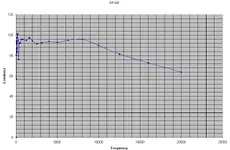A
aznwonderboy
New member
Um...I did some reading before posting this. Granted, many posts have discussed the topic of using an SPL meter to measure the frequency response of room/monitors. However, I learned that those threads are very conflicting and confusing, often sidetrack, or offer solutions that I cannot afford to take.
I have plotted a frequency response graph of my monitors the SP-5B in my room. I am hoping that you guys can provide some quick fix to improve the response as much as possible without making me spend any more money.
Bass traps? - No thanks. Those cost money and a load of more headaches.
Move the monitors? - Sure. Um...how? where? Do I have to go through the entire test tone CD and graph the whole spectrum again after every little nudge I make to the monitors (that will waste a lot of time since plotting the whole spectrum took me an hour)?
Here's what I did to analyze my monitors. I downloaded a test tone CD. I put the SPL meter on a tripod at my ears' position right inside the equilateral triangle. Then, I played the pink noise and adjusted the volume on the monitors so that the SPL meter displays 82dB. {Some people used the tone 1Khz as the reference at 85dB. I didn't do this. Does it matter?} At that volume setting, I began to play each test tone and write down the SPL meter's reading at that frequency. Whoo! That was very tedious, especially with the bass test tones.
I am attaching my graphs. Please tell me what can I do with it?
I have plotted a frequency response graph of my monitors the SP-5B in my room. I am hoping that you guys can provide some quick fix to improve the response as much as possible without making me spend any more money.
Bass traps? - No thanks. Those cost money and a load of more headaches.
Move the monitors? - Sure. Um...how? where? Do I have to go through the entire test tone CD and graph the whole spectrum again after every little nudge I make to the monitors (that will waste a lot of time since plotting the whole spectrum took me an hour)?
Here's what I did to analyze my monitors. I downloaded a test tone CD. I put the SPL meter on a tripod at my ears' position right inside the equilateral triangle. Then, I played the pink noise and adjusted the volume on the monitors so that the SPL meter displays 82dB. {Some people used the tone 1Khz as the reference at 85dB. I didn't do this. Does it matter?} At that volume setting, I began to play each test tone and write down the SPL meter's reading at that frequency. Whoo! That was very tedious, especially with the bass test tones.
I am attaching my graphs. Please tell me what can I do with it?
Attachments
Last edited:






